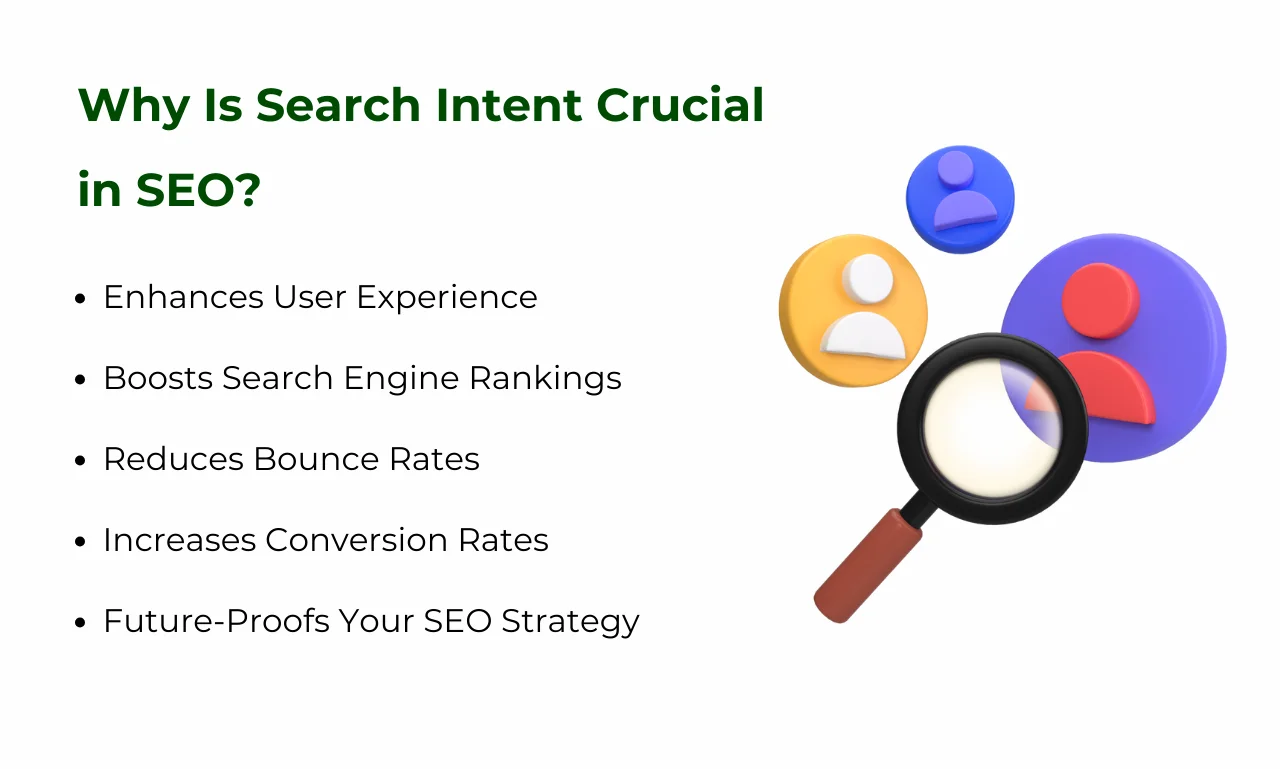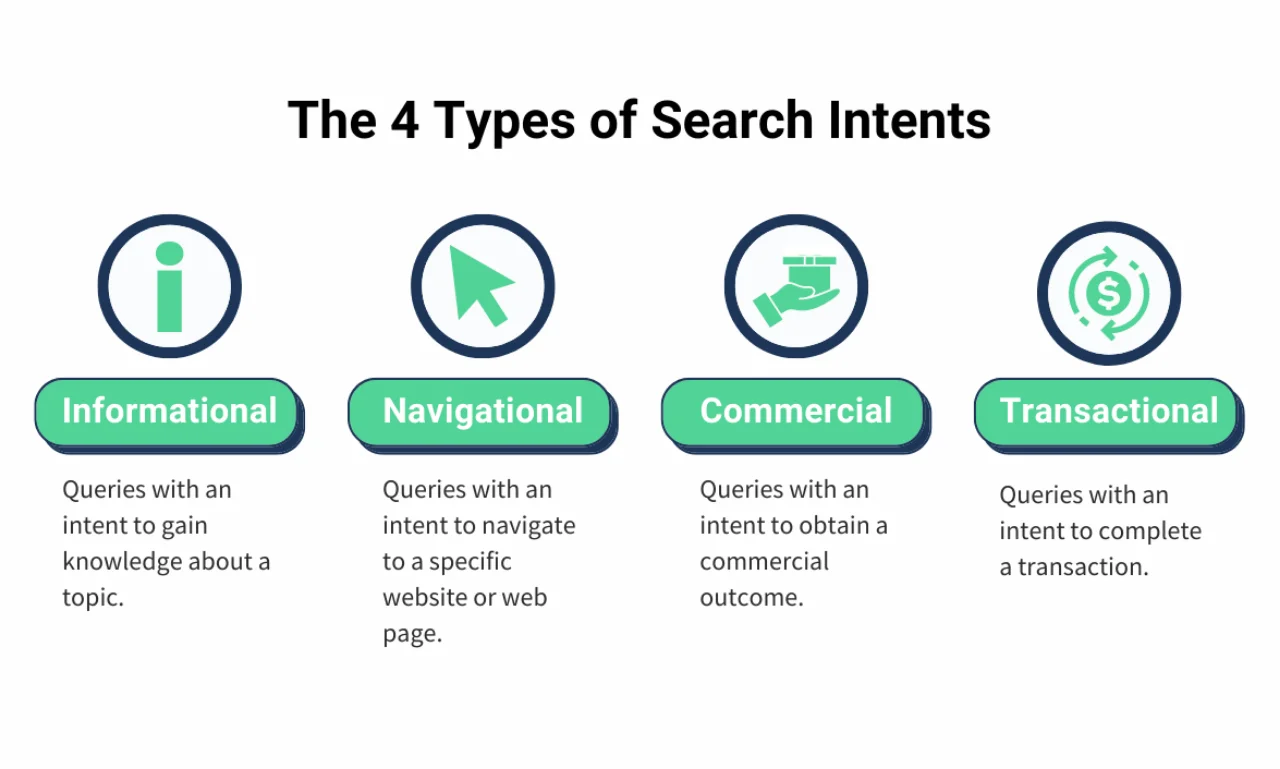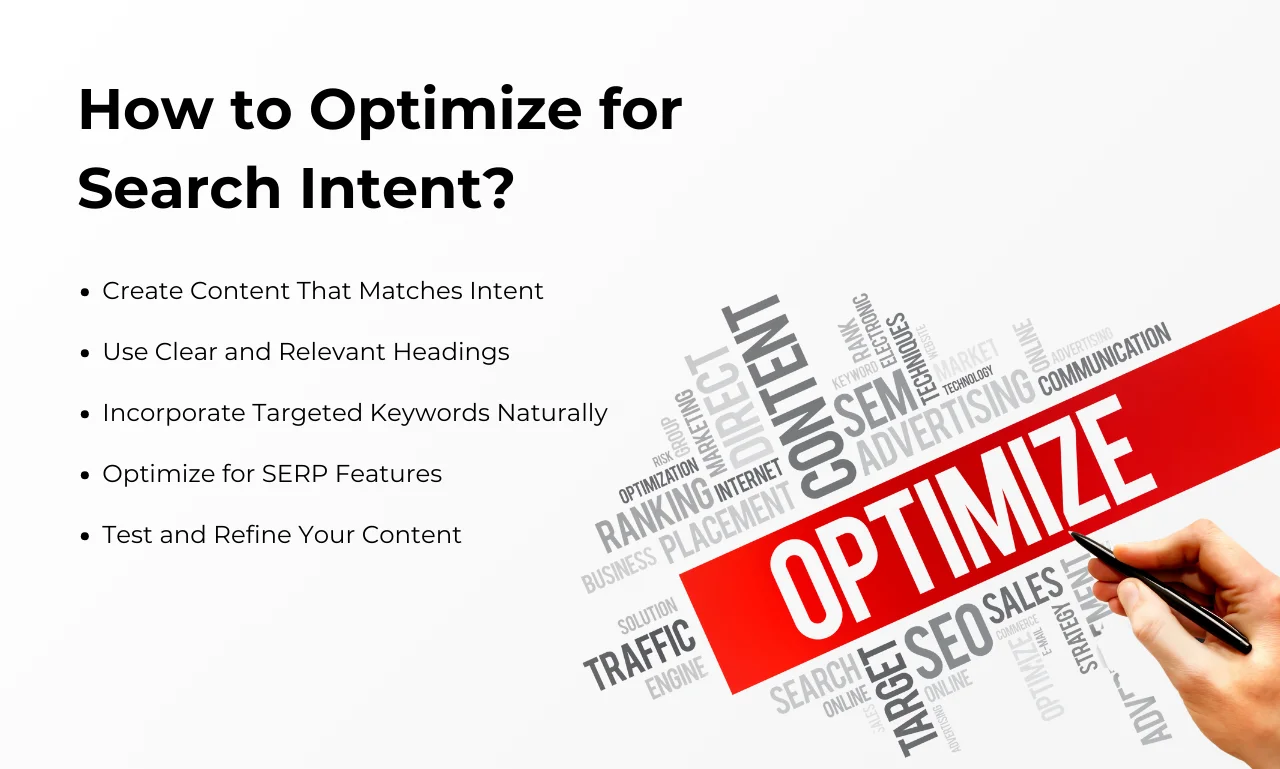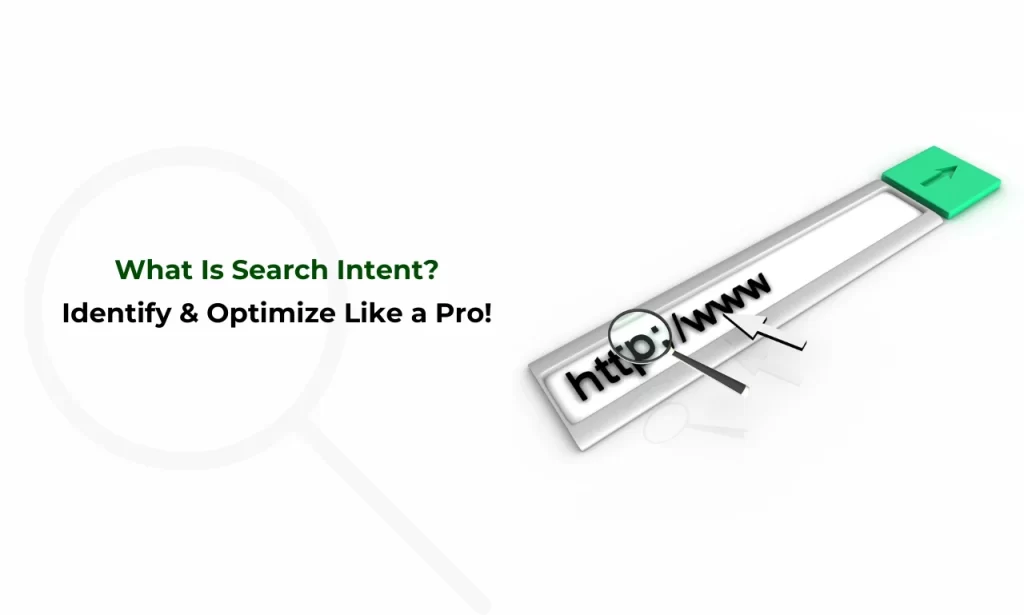The knowledge of search intent or user query will go a long way in delivering the right message to your audience.
Understanding local search intent is a significant factor while devising SEO strategies for your website.
Search intent is related to a user entering a particular search query into a search engine.
This is the way to open a new level of engagement and achieve a greater understanding of what is important to your readership and what they will want to read.
In this blog post let me explain the process of how you can figure out the search intent and how you can make content to match the user’s expectations.
What Is Search Intent?
Search intent (User Intent) is the reason behind the search query of the user on the search engine. There is a certain set of keywords that a user enters into a search engine to get the required knowledge.
The knowledge of such an aspect helps to generate materials that meet the needs and expectations of users, which makes this concept an inseparable element of modern SEO.
In other words, Search intent is concerned with matching users with the right content that provides an answer to a query or meets a given need.

Why Is Search Intent Crucial in SEO?
From the Search Engine Optimization (SEO) point of view, search intent is very crucial because it helps to provide content aligned with user intent. Let’s understand how keyword intent guide to SEO success:
Enhances User Experience:
Users find search results more relevant because it is only showcasing content that aligns with what the users are looking for.
For instance, once a user gets to a page that is meant to fulfill his or her search needs, this is considered a positive occurrence. It not only gives them the impetus to spend more time on the site but also gives a good probability that they will come back later.
Boosts Search Engine Rankings:
Search engines such as Google, Bing, and Yahoo are interested in content that serves the intended goals and objectives of the users.
When the content of your page answers the question that a user most likely typed in the search bar, you inform the search systems that your resource is worthy. This increases the likelihood that your content appears on the page and channel if your target audience is searching the web with the use of specific keywords that match the content of your posts.
Reduces Bounce Rates:
Relevant content keeps users engaged. If a page serves the intended need of a user, the latter spends less time on the page which makes the bounce rates lower. It also helps the search engines to know that your site has relevant content when you have a low bounce rate hence promoting your SEO.
Increases Conversion Rates:
By having knowledge of types of search intent, you can create content that is in line with the needs of the users. When people have been able to get what they initially searched for, then there is a high chance that they will take the intended action which may include purchasing, joining a list or even filling out a contact form. This leads to increased conversion rates and higher ROI of your SEO plans and strategies.
Future-Proofs Your SEO Strategy:
The focus of every SEO strategy whether it is local SEO or international SEO is to evolve and develop through constantly changing elements such as search engine algorithms as well as users’ behaviors. They can help you adjust your SEO strategy because it is more useful to target search intent. This makes them versatile and priceless in making your content unchallengeable and relevant to the ever-evolving search engine result pages
Types of Search Intent:
The concept of search intent or the purpose of a user query can be completely summarized into four types, such as informational, navigational, transactional, and commercial investigational.
Understanding search intent enables marketers to create content that meets customer needs and wants. It is always important to focus on the type of search that is being used when evaluating the content to create. Here are the four main types:

Informational Search Intent:
Informational user goals are to find some information, explanation, clarification or just to learn about the information. They can include words such as how, what, why, and so on, for instance, how to, what is, and why.
For example, a person performing a query search such as ‘how to optimize for search intent in Dubai’ is seeking information and advice. To consider this intent useful to the reader, the full detailed information should be provided that can help the reader to answer their questions.
Navigational Search Intent
Navigational intention on the other hand is characterized by the need to locate a particular URL. This is especially the case when the search is done using brand names or website names. For instance, if a person searches for the Three Angle Marketing website, navigational intent is behind their search. To further this intent, it is wise to make your brand easily searchable and prominently featured on the website.
Transactional Search Intent:
Pre-purchase consumers refer to clients with a transactional use of the website, meaning that they are willing to make orders or take any other action regarding the offer a company is giving. It is important for their often-used keywords to include “buy”, “order”, or “download”.
For instance, ‘buy SEO tools online’ implies the buyer is willing to purchase. When it comes to this specific intent, the optimization should be concentrated on creating materials that drive the operation, like the product pages, the process of the checkout, or calls to action.
Commercial Search Intent:
Commercial investigation intent is all about users’ comparison of their products or services before choosing any of them. They might use such words as “best”, “review” or “comparison” to help them to classify the articles.
Such as, when a user searches for ‘best SEO tools 2023’, it indicates that the individual is making a decision. To achieve this intent, offer detailed forms of reviews, comparisons and other ultimate guides that would assist users with sound decision-making.
Why Does Search Intent Go Beyond Basic Categories?
One thing you must understand is that there are many types of search intent. Even in the same category, the distinctions in the behavior of use may be rather large.
For instance, an informational need expressed in “best running shoes” may be of a user searching for a recommendation from past users while another user may be searching for advice on which type fits their feet.
This is of great benefit as it enables marketers to easily distinguish boundaries when making content. Let’s have a look at different reasons which forced the search intent go beyond the basic categories:
Nuances in User Behavior:
The user behavior is not easy to define and can be characterized by many aspects. Even if the user enters the same phrase, he or she is likely to provide a different intent. For example, a search such as “how to bake a cake” will have one person searching for a plain recipe while another searching for expert advice. Such insights help in creating content that fits the given user needs.
Context Matters:
There are three main dimensions with regard to the contextual factors which are location, device, and time. The intent of a user who is doing the search “restaurants near me” using a smartphone at lunchtime is different from that of a person who is using a desktop computer in the evening. Understanding those contextual factors can help marketers to customize the content in certain circumstances.
Evolving Search Queries:
The various search queries that users are using are more conversational and sophisticated. Sometimes users begin their queries with information requests such as, “Could you suggest an Italian restaurant downtown?” Due to the increased usage of conversational queries, marketers have to change their content approach to fit this new type of search engine results.
Personalization in Search Results:
Currently, search engines are beginning to increase tendencies to deliver results that are specific to the given user preferences. If two users are searching for the same term, then they may be given a different filter bubble based on the past behavior of the two customers. Gaining recognition of the ways in which personalization influences the outcome is definitely valuable knowledge to marketing experts.
The Role of Long-Tail Keywords:
Specific keywords, and sometimes longer than regular keywords, are the long-tail keywords that show further truthful intents of consumers. For instance, the particular keyword ‘Best Digital Marketing Agency in Dubai.’ is more specific than the general search ‘Digital Marketing Agency.’ Therefore, when choosing relevant keywords, long-tail keywords help target consumers’ needs much better.
How to Identify & Conduct a Keyword’s Search Intent?
Identifying & Conducting search intent can be done by a blend of keyword searches, analyzing your audience’s behavior, and understanding their needs. Below are recommendations that would help you identify the search intent:

Analyze the Search Query:
Firstly, understand the components and wordings of the query given. Search for words that might show the user’s purpose, “guide,” “guide to,” “guide of,” or “guide for.”
It is pivotal to how and what the user is looking for and can be deduced through analyzing the query’s structure.
You can begin with an exploration of the queries used by your target audience. It is necessary to pay attention to what other words are used in connection with these keywords and other adjectives that are used with such nouns.
Also, understand questions like
- Does the visitor want to gather information?
- Is he or she in need of a particular site?
- Are they prepared to make a purchase or are they comparing a few choices?
This should help you come up with an understanding of the real motives of these actors.
Consider the User’s Journey:
Consider the stage of the decision-making process from the user’s point of view when they are looking for your keywords.
It distinguishes between the first-time exposure to the topic and the case where the consumer is ready to actually go ahead and buy the product.
This approach helps you to understand about the user and their attitudes toward the content that you will be creating at any given stage of the process.
Use Google’s “People Also Ask” and “Related Searches”:
The “People Also Ask” and “Related Searches” tabs at the bottom of the Google SERPs can be very informative concerning the search intent of users. These sections reflect some of the questions and corresponding queries that may be asked based on the keywords used by the users.
Examine SERP Features:
The 3 common elements that are incorporated in Today’s Search Engine Results Pages (SERPs) include featured snippets, reviews, and local packs. Such SERP features can inform about the type of content users are searching for.
For instance, when a different colored background encloses a drop-down block called ‘featured snippet from the page,’ it represents information-seeking intent.
Study Competitor Content:
Determine what competitors place about the query and how they meet it. It can be useful for understanding the strategies that will help you understand all areas of your content that may be missing. By analyzing competitors, you can develop a content strategy that ensures that the delivered material is more distinctive and beneficial.
Use Keyword Research Tools:
Use Google Keyword Planner, Ahrefs, or SEMrush to identify current trends and behavior of the audience with specific search intents. These tools may be useful to understand keyword search volume, keyword difficulty, long tail keywords, short tail keywords, local keyword research, competition data, and other related keywords, which shall assist in understanding the intention.
Consider User Behavior Metrics:
It is also possible to understand user intent through details such as click-through rates (CTR) and dwell time. This is so simple because a high click-through rate and long dwell time show that the users find the content to be useful and interesting. These metrics can be helpful in enhancing content marketing strategies on the basis of receptiveness exhibited by the users.
Use Relevant Keywords:
It is wise to use the relevant keywords organically within the text. When writing, try to use such phrases and terms your user would use, including in the title header and body of your content.
This strategy is quite helpful from the SEO point of view but it also ensures that the content you are creating answers the questions of your audience.
Structure Your Content Effectively:
By structuring your content, you can help the search engine and your users to navigate and read it easily. Use headings based on the format headings, use bullets to list points and make short paragraphs to be easy to read. When publishing informational content, you should organize the content in the form of FAQs or sequential guidelines. For the transactional content, the buyer process should be easy, and the instructions to act are simple to follow.
Constant Monitoring:
When it comes to search intent, online changes often occur frequently. So, make sure you make constant checks regarding your content adjustment. Constantly monitor the visitors’ activities, and analyze their bounce rates, and conversion rates through the use of relevant tools. Ensure that you seek feedback from the audience so that you understand their changing needs and preferences.
How to Optimize for Search Intent?
There are certain steps that are usually involved when coming up with an optimization for search intent. Through the help of such steps, you can match the content with the user’s needs to improve your engagement and conversion rate in the process. Here is how you can achieve this:

Create Content That Matches Intent:
Analyzing intent in a question makes it easier for you to meet the users’ requirement regarding the content to be delivered.
Customize Your Content Format:
The content which you are dealing with should in some ways depend on the result of the search query that you are making. For instance:
- Informational Queries: When answering tips on informational queries the blogger can write a blog post, create an infographic, or make an explainer video.
- Functional Queries: Offer articles that provide instructions on how to use products to buy them.
- Navigational Queries: Improve landing pages through the use of proper call to action to guide the user to the particular page.
Use Clear and Relevant Headings:
Clear and relevant headings allow the materials to be organized in a convenient way and facilitate finding the information related to a particular topic. Make use of heading to target the client’s question to them and help them navigate your content easily. This not only increases the readability of your content but is also beneficial for making your content featured on snippets.
Incorporate Targeted Keywords Naturally:
Keywords are the link between your content and search queries done by internet users out there in the internet realm. It is crucial to notice that the keywords should match the intent of the search. However, avoid keyword stuffing. Just include them into the text naturally to make the text more readable and relevant.
Optimize for SERP Features:
SERPs features provide attributes of different elements such as featured snippets, knowledge panels, and local packs. Their aim was to achieve better results in the following ways:
- Writing concise, well-structured content.
- Provide search engines with formatted data so that they can process your content and rank it appropriately.
- Answering common questions directly within the content is a tactic that you should implement.
Test and Refine Your Content:
You need to test and refine your content constantly because of constant changes in search engine algorithms. So, make sure your content aligns with the intended search intent. Conduct A/B testing and analysis to understand if the provided content is satisfactory in the eyes of your users. Adapt different strategies to make content more efficient and effective for search engines and users.
Tools to Optimize for Search Intent
There are many tools that can help you to optimize the search intent. Here are some of the most effective ones that you can consider:
Google Analytics and Search Console:
This tool will provide insight into the users and their behavior and also the performance of the search. Learn how relevant your content is to the intent of the person visiting the site by comparing some parameters such as the bounce rate, the time the visitors spend on your site, and where they are originating from.
Ahrefs, SEMrush, and Moz:
Such tools are very useful for determining keyword success factors through analysis of the SERP position. Use them to pick high performing keywords and even know the approach your competitors are pursuing.
AnswerThePublic:
Use AnswerThePublic and see for yourself general and specific questions connected with your topic. This tool helps you generate content based on the questions that are being asked online.
Surfer SEO and Clearscope:
These two tools are useful for expanding your content for its relevance as well as for the keyword occurrences. These help in recommending articles from other articles that are popular and any content produced can be matched with these expectations.
Heatmap Tools (e.g., Hotjar):
The heat map tools will assist you to identify how individuals interrelate with your content. Concerning the areas of improvement, users can take some statistical factors including click-stream analysis, scroll down, and other relevant actions.
Ready to Create Content That Users Want to See?
At Three Angle Marketing, the focus of our content experts is to create content with the intent that creates outcomes that you want to see. Our team of SEO specialists is ready to enrich your content to meet users’ intent and get the best results from the search.
It is now possible for you to enhance your potential benefit with Three Angle Marketing. Our experience in SEO techniques will help you to develop web content that will be not only optimized but also rank well in the search engines. This way you can make your users happy when they read your content.
Highlight of Expertise:
Client satisfaction is something we value greatly and that is why we ensure that the content we produce reflects the client’s keyword intent. In this approach, we always shift our attention to the ways that will best suit your users and meet your aim of converting them.
Free Consultation or Audit Offer:
Want to enhance the effectiveness of your content based on search intent? Here you can approach us for a free consultation or get a content audit, we can discuss and create your best SEO plan.


